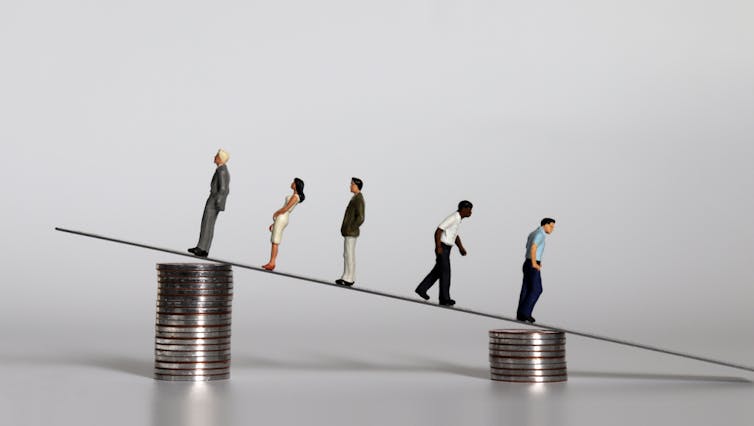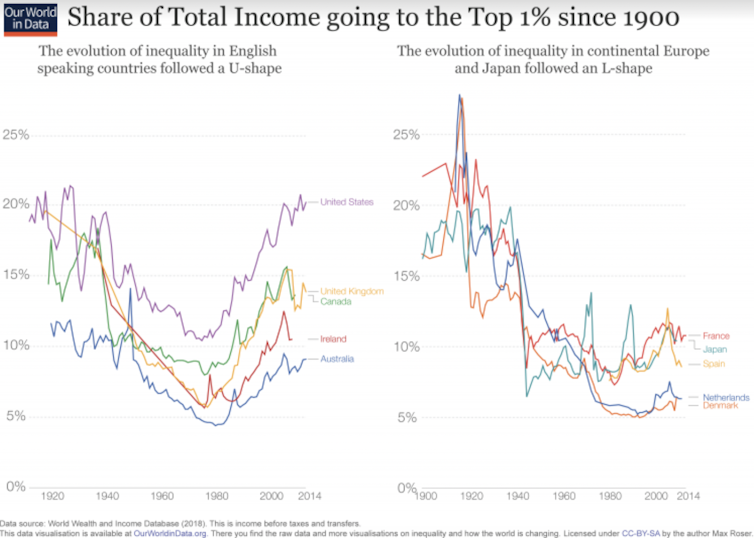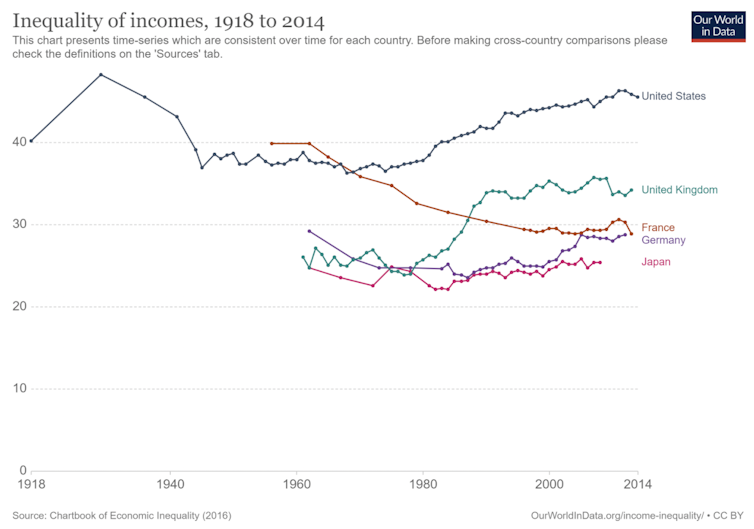Covid pandemic: How rising inequalities unfolded and why we cannot afford to ignore it

By Ian Goldin, University of Oxford
Historian Walter Scheidel argues in The Great Leveler that pandemics are among the four great horsemen that, through history, have led to greater equality – the others being war, revolution and state failure. Economist Thomas Piketty in Capital in the Twenty-First Century similarly points out that the world wars and the flu pandemic in 1918 and 1919 contributed to the decline in inequality after 1945. But while mass death can drive up workers’ wages through a reduction in the workforce, pandemics are neither a necessary nor sufficient basis for reducing inequality.
Far from being a “great equaliser”, COVID-19 has revealed and compounded existing inequalities in wealth, race, gender, age, education and geographical location.
The pandemic of 2020 does not compare to the Black Death, which killed a third of Europe’s population, or the 1918 flu, which killed around a third of the world’s population. The consequence of this pandemic is rising unemployment, not a shortage of available labour, as was the case with these earlier crises. Meanwhile, unlike the Great Depression and previous periods of crisis, during COVID-19 stock markets and the assets of the wealthy soared in value, widening the gap between rich and poor.
To assume this pandemic will inevitably lead to reductions in inequality and usher in a better world would be irresponsible. The first world war was certainly no great leveller. Far from it leading to better conditions, inequality in many countries peaked in the early 1920s. By the 1930s, with the onset of the Great Depression, there was widespread unemployment and destitution in the US, UK and Europe. The contrast with the progress that followed the second world war reveals that we cannot tell in advance what these cataclysmic crises will bring. It is human actions and leaders that shape societies, not simply events.
In my book Rescue: From Global Crisis to a Better World, I identify how individuals, businesses and governments can precipitate change to reduce inequality, which was rising in both Europe and the US before COVID-19 struck. The pandemic only accelerated this trend.
After being relatively stable in the decades following the second world war, the labour share of total income has been falling in the US, Europe and UK since the 1980s. This is mainly due to the tide of liberalisation that was ushered in when Margaret Thatcher in Britain and Ronald Reagan in the US initiated a race to the bottom in taxation, attacks on trade unions, and a weakening of competition policy, which all allowed for the growing concentration and strength of employers.

Our World in Data, CC BY
The public spending gap
Now, among high-income countries, the US is by far the most unequal, followed by the UK. It is in these countries that the neoliberal crusade – which sought to reduce the size of government through reducing taxes and redistribution, privatise state enterprises and utilities, undermine the power of trade unions, and roll back rules that limited the free rein of the private sector – has advanced the furthest. Lower levels of inequality in northern European countries and in East Asia since the 1970s are due to both higher levels of welfare payments for those in need, and higher public investment in education, health and housing, which are financed by higher levels of taxes on the wealthy.
Both require considerable budgetary resources, and since the financial crisis of 2008, with rising unemployment and a deterioration of already weak public finances, southern European countries have been less able to afford the largesse that in Germany accounts for over 20% of government spending. Workers in Italy, Spain and eastern European countries such as Poland and Hungary have not seen anything like the levels of support enjoyed by their northern neighbours. The result has been a rapid increase in inequality in the southern countries and growing divides within Europe.
How inequalities unfolded
The pandemic increased both economic and health inequalities due to a range of intersecting factors, which compounded each other. The wealthy were not only able to keep their well-paid jobs but also benefited from soaring stock markets and rising house prices. Low-paid workers were, in contrast, more likely to have jobs in the sectors that suspended activities, including hospitality and tourism. They were also more likely to work in essential services such as nursing, policing, teaching, cleaning, waste removal and as shop assistants – in all of which occupations, they had a higher likelihood of being exposed to COVID-19. The risk of contagion was further elevated by their living in more crowded homes, apartment buildings with communal lifts and entrances, and on their being more reliant on public transport.
As COVID-19 peaked in their neighbourhoods, they were also more likely to be locked down, which further undermined incomes. Weaker health facilities in their neighbourhoods meant mortality rates were higher, with a higher incidence of existing health problems also increasing their vulnerability.
A higher share of poor workers are in precarious hourly paid employment, making them less able to access social security, health insurance and emergency benefits that could cushion the decline in income and the effect of COVID-19 on their lives. The pandemic has come on top of a decade of austerity and stagnating wages in the UK, US and many other countries, deepening the hardship endured by growing numbers of people.
Taxes that fund redistributive spending – in the form of health and education, as well as social security, housing, child, disability and other benefits – can all significantly help overcome inequality. Before taking account of taxes and government spending, inequality is almost as high in France as in the US and UK, and even higher in Ireland, which without redistribution would be the most unequal of the world’s 34 richest countries. However, in Ireland and France, taxation and redistribution have reduced inequality to levels that are well below that in the UK.

Our World in Data, CC BY
Meanwhile, the failure of successive governments in the US to use taxation and spending to overcome inequality means it is the most persistently unequal of all the rich countries. Overcoming inequality requires higher wealth and inheritance taxes for the upper-income families who have seen their wealth rise dramatically in recent decades.
As I show in Rescue, young people have been particularly hard-hit by the pandemic. To protect the health of the elderly, they have sacrificed their education, job prospects and social lives, and in future years will inherit much higher levels of public debt. Now, as happened after the second world war, we need to ensure that they can look forward to a sustainable and brighter future. This requires higher levels of investment in education, improved job prospects and a focus on social mobility, including through higher levels of inheritance and wealth taxes.
COVID-19, by exacerbating and further revealing the extent of inequality and discrimination, has made the case for addressing these injustices more compelling than ever. In response to the pandemic, governments and businesses have acted in ways that would not have been considered possible in January 2020. The challenge now is to build on these initiatives to reduce discrimination and inequality everywhere.
The International Public Policy Observatory, of which The Conversation is a partner, is holding a major Action On Inequalities event on Tuesday June 15, from 10am. If you are interested in attending, email ippo@ucl.ac.uk or sign up here.![]()
Ian Goldin, Professor of Globalisation and Development; Director of the Oxford Martin Programmes on Technological and Economic Change and Future of Development, University of Oxford
This article is republished from The Conversation under a Creative Commons license. Read the original article.